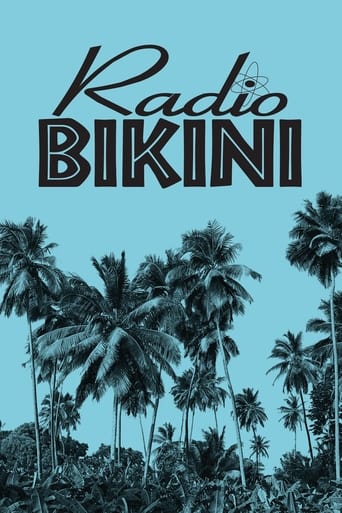Radio Bikini (1988)
It starts with a live radio broadcast from the Bikini Atoll a few days before it is annihilated by a nuclear test. Shows great footage from these times and tells the story of the US Navy Sailors who were exposed to radioactive fallout. One interviewed sailor suffered grotesquely swollen limbs and he is shown being interviewed with enormous left arm and hand.
Watch Trailer
Cast


Reviews
Very interesting film. Was caught on the premise when seeing the trailer but unsure as to what the outcome would be for the showing. As it turns out, it was a very good film.
Entertaining from beginning to end, it maintains the spirit of the franchise while establishing it's own seal with a fun cast
It really made me laugh, but for some moments I was tearing up because I could relate so much.
It is a whirlwind of delight --- attractive actors, stunning couture, spectacular sets and outrageous parties. It's a feast for the eyes. But what really makes this dramedy work is the acting.
This is a superb documentary and a very sombre film perhaps to be expected from the subject matter. With World War II over, the United States now engages in peaceful testing of atomic bombs, and the film documents the first of the post-War tests, on Bikini Atoll in the South Pacific. The tests were probably inevitable. Once the genie had been let out of the bottle with Hiroshima and Nagasaki, it wasn't going to be stuffed back in. After watching this, you do perhaps wish it had been though.You're first disturbed at the uprooting of the inhabitants of Bikini. They have nothing to do with this; they had nothing to do with the recently ended war; they want to be left alone. But the US military forces them off Bikini, because for whatever reason, Bikini is deemed the perfect place to do ongoing atomic testing. You can't help but feel sorry for these people. There are the shots of animals being chained to poles on derelict ships around Bikini Atoll, in preparation for the dropping of the bomb, just to see what will happen to them. I found quite haunting the words of the narrator on a newsreel from the time as the plane carrying the bomb approaches Bikini, "these animals are about to draw their last breaths in the service of humanity." And then there are the American sailors on board the ships that are conducting the testing. They're given no protective clothing. After the second (underwater) test radioactive water is brought into the ships for them to drink and shower in. Was this just ignorance - or were the sailors themselves being used as guinea pigs - as unknowingly as the animals who had just been incinerated? And, of course, there was John Smitherman - a veteran of the tests, who had lost both legs over the years as they had swelled up and eventually burst open, and whose left hand was now swollen and barely recognizable as a hand - a victim of the radiation. Sombre, indeed.As backdrop, there's some of the diplomatic manoeuvring going on, as the United States wants to share this with the world, and the Soviet Union says it has no interest in the bomb. A truly superb documentary. (8/10)
In 1982, the excellent "The Atomic Cafe" was released. That movie succeeded both as an informative documentary and as an offbeat comedy. The horrible destructiveness of the new atom bomb was balanced by the likable goofiness of the American public at the time, and the result was an entertaining and thoughtful treatment of the subject.The makers of Radio Bikini evidently felt that Cafe needed to be re-released with all of its entertainment value stripped away and replaced with lots of graphic footage of ugly details and government mistakes. It starts with footage of Americans celebrating the surrender of the Japanese and the end of WWII, but for some reason this sequence is set to a funeral dirge. This dreary, overlong sequence sets the tone for the rest of the film. Pompous political speeches, graphic footage of animals being locked down for blast tests, an interview with a dying man... the only thing that keeps it from being preachy is the muddled presentation of the material.This movie is a pointless, tedious remake of a much better film. Do yourself a favor and rent "The Atomic Cafe". Don't waste your time on this one.
In the wake of World War II the United States, with its monopoly on atomic weapons, was not above deciding to flex its nuclear muscles in two early tests of atomic bombs near the Bikini Atoll in the Marshall Islands in 1946. It was interesting to see that even in that time the President (Truman) was invoking God in support of our development and use of the bomb. God had granted us the favor of having the bomb and Truman beseeched him to guide us in its proper use. This short one-hour documentary about the two atomic tests provides material for debate as to whether Truman's requests of God have been met.The United States had the hubris to evacuate the entire island of Bikini in order to conduct its tests, telling the islanders that it was in the interest of the welfare of mankind. This evacuation is personalized in this film by comments from Kilon Bauno, the chief of the Bikini islanders. Bauno and the islanders had no real idea of what was going on and why they were being forced off of their homeland. The shots of the islanders being loaded into ships are heart rending.I used to think that the trust of the U.S. Government started on its downhill slid during and after Vietnam, but we can see here that its origins are earlier. When we see the P.R. footage of the medical doctor assuring us that every possible safety precaution had been taken and there was absolutely no danger to anyone involved in these tests, and then later see the sailors lighting up the Geiger counters, we experience what has in later years become that all too common reaction of less than total faith in what our government tells us. After all we did have the Japan bombings as a cautionary warning.This documentary could be an indoctrination film for PETA. Some of the most agonizing clips for me were those that dealt with the use of goats as experimental animals in the tests. They were confined in small metal cages and set afloat on test ships. Seeing the animals struggle to get out of their restraints was difficult and then, after the tests, the horribly burned animals were displayed as if trophies of some major victory. Truly disturbing.There is much footage of the blasts themselves. The sad truth is that the release of such power is awe-inspiring and fascinating. This is perhaps part of the motivation for developing these devices - to witness this elemental force. There is also the element of not being able to restrain men from playing with their toys. But realizing the potential of using such toys for evil tempers any attractions. However, understanding that potential has also prevented any major war in the last sixty years. But the idea of an atomic bomb in the hands of a terrorist is a truly frightening prospect. Certainly the advent of nuclear power has made our world a much more complicated place to understand and deal with.We can see the beginnings of the cold war here. The U.S. proposed a plan for controlling nuclear weaponry to which the official response from the Soviet Union was to say that nuclear weapons should be outlawed entirely - this at a time when they were actively pursuing their own nuclear weapons program.To be fair this is not a documentary without a point of view. A small bow is made to the voices of concern about these tests, in particular a clip of Albert Einstein endorsing such concern. But the emphasis is on the arrogance and naivety of the decision makers. The ukulele music played over the Bikini evacuation heightens the pathos of the situation. The interviews with John Smitherman, who was at the tests, were poignant. Smitherman later developed grotesque swellings in his legs to the point where he had to have them amputated, and his left hand, to which we are treated to a close-up, swelled to the size of a football. Also, I felt a bit manipulated by Smitherman's being shown from the waist up until the end when the camera pulls back for us to see his grievous injuries. Effective, but I felt taken advantage of. And just how common a case is Smitherman's? The film was made some forty years after the tests and much data would have been available as to what the ultimate fate was for many of those there at the time. I wanted more information about the aftermath - what happened to the islanders and the island itself, what happened to that area of the Marshall islands, what happened to the sailors, what was the future of atomic testing, and so forth.Whatever its flaws this is an important and thought-provoking documentary that offers us a small time capsule of a crucial time in history.
What I found interesting about this documentary is the glimpse it gives us of the state of mind of the United States just after World War II, now sixty years past. We see in the newsreel and other film footage the style and substance of America in the afterglow of our greatest victory. But mostly we see ordinary soldiers and sailors who were stationed on or near the Bikini Atoll in the Marshalls in the South Pacific. We also see some of the islanders whom the United States military displaced so that the capabilities of the atom bomb could be explored.An old uneducated Bikini islander recalls how his people were told that in the interest of "science" (but actually in the interest of weapons development) they would have to leave their home island and be relocated. Then at some point they were told that they would not be able to return to their island since it was "poisoned." Film maker Robert Stone shows us the big media build up orchestrated by the US to justify dropping the bomb on Bikini. (Actually one bomb was dropped. Another was exploded under water in the Bikini lagoon.) Dignitaries and scientists from all over the world were invited to watch. Stone shows them arriving and being greeted by the officer in charge as a voice-over gives their names, country of origin and their titles. I found that interesting. Two from India, a couple from the USSR, some Asians, and many more. Ah, yes, the US was going to make the world safe from nuclear power by experimenting with nuclear power.Or some such argument. I thought the dignitaries were positively drooling. Not drooling were the goats and sheep (sheared so that the scientists could see the effects of the radiation on their bare skin) who were trapped in little stalls aboard strategically placed ships near the island. Also not drooling, but having a good time were the sailors who with dark glasses viewed the blast from some safe distance on their ships. They were happy because it looked like an easy duty, and were told that there was no danger. Radiation was never mentioned, and in those days, the dangers of radiation were only just becoming public knowledge. Stone has footage of an interview with one of the sailors years later, only his head and shoulders shown for most of the documentary until near the end when the camera retreats a little and we can see what grotesque things the radiation poisoning did to him. It's pretty shocking footage, and you won't forget it.We see the blasts and the mushroom clouds and the magnificent glory of the power of the bomb. Unfortunately some observers were down wind and radioactive dust fell upon them. Unfortunately some observers boarded the ships that suffered damage from the blasts (but were far enough away so as not to be destroyed) and got radioactive dust on their clothes and skin. Stone shows the sailors exploring the damage while being scanned by Geiger counters going crazy monitoring the radiation. One is struck by the innocence and playfulness of the sailors as the radiation begins its work on their bodies.In other words this is a snapshot from the dawn of the nuclear age, strangely innocent and diabolical at the same time. I don't think this is a great documentary, but I will say it is effective. For the complete story of what happened at the Bikini Atoll and especially what happened to the islanders who lost their homes and to those exposed to the radiation, the viewer will have to look elsewhere. This is merely an introduction.(Note: Over 500 of my movie reviews are now available in my book "Cut to the Chaise Lounge or I Can't Believe I Swallowed the Remote!" Get it at Amazon!)







